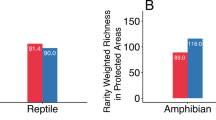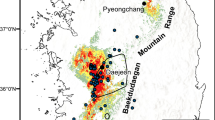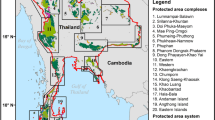Abstract
Habitat transformations caused by human land-use change are considered major drivers of ongoing biodiversity loss1,2,3, and their impact on biodiversity is expected to increase further this century4,5,6. Here, we used global decadal land-use projections to year 2070 for a range of shared socioeconomic pathways, which are linked to particular representative concentration pathways, to evaluate potential losses in range-wide suitable habitat and extinction risks for approximately 19,400 species of amphibians, birds and mammals. Substantial declines in suitable habitat are identified for species worldwide, with approximately 1,700 species expected to become imperilled due to land-use change alone. National stewardship for species highlights certain South American, Southeast Asian and African countries that are in particular need of proactive conservation planning. These geographically explicit projections and model workflows embedded in the Map of Life infrastructure are provided to facilitate the scrutiny, improvements and future updates needed for an ongoing and readily updated assessment of changing biodiversity. These forward-looking assessments and informatics tools are intended to support national conservation action and policies for addressing climate change and land-use change impacts on biodiversity.
This is a preview of subscription content, access via your institution
Access options
Access Nature and 54 other Nature Portfolio journals
Get Nature+, our best-value online-access subscription
$29.99 / 30 days
cancel any time
Subscribe to this journal
Receive 12 print issues and online access
$209.00 per year
only $17.42 per issue
Buy this article
- Purchase on Springer Link
- Instant access to full article PDF
Prices may be subject to local taxes which are calculated during checkout




Similar content being viewed by others
Data availability
The data supporting the findings of this study are available in the Supplementary information and at the Map of Life website (https://mol.org).
References
Cardinale, B. J. et al. Biodiversity loss and its impact on humanity. Nature 486, 59–67 (2012).
Sala, O. E. et al. Global biodiversity scenarios for the year 2100. Science 287, 1770–1774 (2000).
Duraiappah, A. K. et al. Ecosystems and Human Well-being: Biodiversity Synthesis. (World Resources Institute, Washington, DC, 2005.
Jetz, W., Wilcove, D. S. & Dobson, A. P. Projected impacts of climate and land-use change on the global diversity of birds. PLoS Biol. 5, 1211–1219 (2007).
Newbold, T. et al. Global effects of land use on local terrestrial biodiversity. Nature 520, 45–50 (2015).
Visconti, P. et al. Projecting global biodiversity indicators under future development scenarios. Conserv. Lett. 9, 5–13 (2016).
Rondinini, C. & Visconti, P. Scenarios of large mammal loss in Europe for the 21st century. Conserv. Biol. 29, 1028–1036 (2015).
Betts, M. G. et al. Global forest loss disproportionately erodes biodiversity in intact landscapes. Nature 547, 441–444 (2017).
Hurlbert, A. H. & Jetz, W. Species richness, hotspots, and the scale dependence of range maps in ecology and conservation. Proc. Natl Acad. Sci. USA 104, 13384–13389 (2007).
Jetz, W., Sekercioglu, C. H. & Watson, J. E. Ecological correlates and conservation implications of overestimating species geographic ranges. Conserv. Biol. 22, 110–119 (2008).
Amatulli, G. et al. A suite of global, cross-scale topographic variables for environmental and biodiversity modeling. Scientific Data 5, 180040 (2018).
Hurtt, G., Chini, L., Sahajpal, R. & Frolking, S. Harmonization of global land-use change and management for the period 850–2100. http://luh.umd.edu/ (2016).
Kim, H. et al. A protocol for an intercomparison of biodiversity and ecosystem services models using harmonized land-use and climate scenarios. Geosci. Model Dev. https://doi.org/10.5194/gmd-2018-115 (2018).
Popp, A. et al. Land-use futures in the shared socio-economic pathways. Glob. Environ. Change 42, 331–345 (2017).
O’Neill, B. C. et al. A new scenario framework for climate change research: the concept of shared socioeconomic pathways. Clim. Change 122, 387–400 (2014).
Riahi, K. et al. The shared socioeconomic pathways and their energy, land use, and greenhouse gas emissions implications: an overview. Glob. Environ. Change 42, 153–168 (2017).
IUCN Standards and Petitions Working Group. Guidelines for Using the IUCN Red List Categories and Criteria. v6.2. Prepared by the Standards and Petitions Working Group of the IUCN SSC Biodiversity Assessments Sub-Committee. https://www.iucnredlist.org/resources/redlistguidelines (2006).
Lawler, J. J. et al. Projected climate‐induced faunal change in the Western hemisphere. Ecology 90, 588–597 (2009).
Warren, R. et al. Quantifying the benefit of early climate change mitigation in avoiding biodiversity loss. Nat. Clim. Change 3, 678–682 (2013).
Blaustein, A. R., Wake, D. B. & Sousa, W. P. Amphibian declines: judging stability, persistence, and susceptibility of populations to local and global extinctions. Conserv. Biol. 8, 60–71 (1994).
Engström, K. et al. Applying Occam’s razor to global agriculture land use change. Environ. Modell. Softw. 75, 212–229 (2016).
Steinbuks, J. & Hertel, T. W. Confronting the food–energy-environment trilemma: global land use in the long run. Environ. Resour. Econ. 63, 545–570 (2016).
Rosa, I. M. et al. Multiscale scenarios for nature futures. Nat. Ecol. Evol. 1, 1416–1419 (2017).
Nixon, A., Fisher, R., Stralberg, D., Bayne, E. & Farr, D. Projected responses of North American grassland songbirds to climate change and habitat availability at their northern range limits in Alberta, Canada. Avian Conserv. Ecol. 11, 1–39 (2016).
Newbold, T. Future effects of climate and land-use change on terrestrial vertebrate community diversity under different scenarios. P. Roy. Soc. B-Biol. Sci. 285, 20180792 (2018).
Pereira, H. M. & Daily, G. C. Modeling biodiversity dynamics in countryside landscapes. Ecology 87, 1877–1885 (2006).
Wearn, O. R., Reuman, D. C. & Ewers, R. M. Extinction debt and windows of conservation opportunity in the Brazilian Amazon. Science 337, 228–232 (2012).
Ceballos, G. & Ehrlich, P. R. Mammal population losses and the extinction crisis. Science 296, 904–907 (2002).
Gaston, K. J. & Fuller, R. A. Commonness, population depletion and conservation biology. Trends Ecol. Evol. 23, 14–19 (2008).
Doherty, T. S., Glen, A. S., Nimmo, D. G., Ritchie, E. G. & Dickman, C. R. Invasive predators and global biodiversity loss. Proc. Natl Acad. Sci. 113, 11261–11265 (2016).
Ripple, W. J. et al. Bushmeat hunting and extinction risk to the world’s mammals. Roy. Soc. Open Sci. 3, 160498 (2016).
Jetz, W., Thomas, G. H., Joy, J. B., Hartmann, K. & Mooers, A. O. The global diversity of birds in space and time. Nature 491, 444–448 (2012).
IUCN. The IUCN Red List of Threatened Species https://www.iucnredlist.org/ (2015).
Farr, T. G. & Kobrick, M. Shuttle radar topography mission produces a wealth of data. Eos Trans Am. Geophys. Union 81, 583–585 (2000).
Robinson, N., Regetz, J. & Guralnick, R. P. EarthEnv-DEM90: a nearly-global, void-free, multi scale smoothed, 90m digital elevation model from fused ASTER and SRTM data. ISPRS J. Photogramm. Remote Sens. 87, 57–67 (2104).
Hansen, M. C. et al. High-resolution global maps of 21st-century forest cover change. Science 342, 850–853 (2013).
Tropek, R. et al. Comment on ‘high-resolution global maps of 21st-century forest cover change’. Science 344, 981 (2014).
Lawrence, D. M. et al. The land use model intercomparison project (LUMIP) contribution to CMIP6: rationale and experimental design. Geosci. Model Dev. 9, 2973–2998 (2016).
Hurtt, G. C. et al. Harmonization of land-use scenarios for the period 1500–2100: 600 years of global gridded annual land-use transitions, wood harvest, and resulting secondary lands. Clim. Change 109, 117–161 (2011).
Hurlbert, A. H. & White, E. P. Disparity between range map- and survey-based analyses of species richness: patterns, processes and implications. Ecol. Lett. 8, 319–327 (2005).
Rondinini, C. et al. Global habitat suitability models of terrestrial mammals. Philos. T. Roy. Soc. B 366, 2633–2641 (2011).
del Hoyo, J., Elliott, A., Sargatal, J. & Christie, D. A. Handbook of the birds of the world. Vol. 1–16 (Lynx Editions, Barcelona, 1992–2011).
Quintero, I. & Jetz, W. Global elevational diversity and diversification of birds. Nature 555, 246–250 (2018).
Gorelick, N. et al. Google Earth engine: planetary-scale geospatial analysis for everyone. Remote Sens. Environ. 202, 18–27 (2017).
Jetz, W., McPherson, J. M. & Guralnick, R. P. Integrating biodiversity distribution knowledge: toward a global map of life. Trends Ecol. Evol. 27, 151–159 (2012).
Gibson, L. et al. Primary forests are irreplaceable for sustaining tropical biodiversity. Nature 478, 378–381 (2011).
Chazdon, R. L. Beyond deforestation: restoring forests and ecosystem services on degraded lands. Science 320, 1458–1460 (2008).
Dent, D. H. & Wright, S. J. The future of tropical species in secondary forests: a quantitative review. Biol. Conserv. 142, 2833–2843 (2009).
Barlow, J. et al. Quantifying the biodiversity value of tropical primary, secondary, and plantation forests. Proc. Natl Acad. Sci. USA 104, 18555–18560 (2007).
Akçakaya, H. R., Butchart, S. H., Mace, G. M., Stuart, S. N. & Hilton-Taylor, C. R. A. I. G. Use and misuse of the IUCN Red List Criteria in projecting climate change impacts on biodiversity. Glob. Change Biol. 12, 2037–2043 (2006).
Acknowledgements
We are grateful to A. Ranipeta and J. Malczyk for support on Google Earth Engine analytics, informatics workflows and web visualizations. We also thank R. Alkemade, J. Hilbers, M.E. Andrew, T. Brichieri-Colombi, V. Lukasik and members of the Jetz Lab at Yale for sharing data, input and feedback. This research was supported by a Natural Sciences and Engineering Research Council of Canada grant to R.P.P. and grants no. NSF DEB 1441737, DBI 1262600, DEB 1558568, NASA NNX11AP72G to W.J. Both authors acknowledge support from the Yale Center for Biodiversity and Global Change.
Author information
Authors and Affiliations
Contributions
W.J. and R.P.P. conceived the study. R.P.P. performed the analysis. W.J. analysed the results. W.J. and R.P.P. wrote the manuscript.
Corresponding author
Additional information
Journal peer review information: Nature Climate Change thanks Richard Corlett and other anonymous reviewer(s) for their contribution to the peer review of this work.
Publisher’s note: Springer Nature remains neutral with regard to jurisdictional claims in published maps and institutional affiliations.
Supplementary information
Supplementary Information
Supplementary Tables 1–6
Rights and permissions
About this article
Cite this article
Powers, R.P., Jetz, W. Global habitat loss and extinction risk of terrestrial vertebrates under future land-use-change scenarios. Nat. Clim. Chang. 9, 323–329 (2019). https://doi.org/10.1038/s41558-019-0406-z
Received:
Accepted:
Published:
Issue Date:
DOI: https://doi.org/10.1038/s41558-019-0406-z
This article is cited by
-
Evaluating density-weighted connectivity of black bears (Ursus americanus) in Glacier National Park with spatial capture–recapture models
Movement Ecology (2024)
-
Conservation genetics and potential geographic distribution modeling of Corybas taliensis, a small ‘sky Island’ orchid species in China
BMC Plant Biology (2024)
-
Land use drives differential resource selection by African elephants in the Greater Mara Ecosystem, Kenya
Movement Ecology (2024)
-
Bat species assemblage predicts coronavirus prevalence
Nature Communications (2024)
-
Modeling responses of Brazilian Atlantic Forest mammals assemble to climate change
Biodiversity and Conservation (2024)



